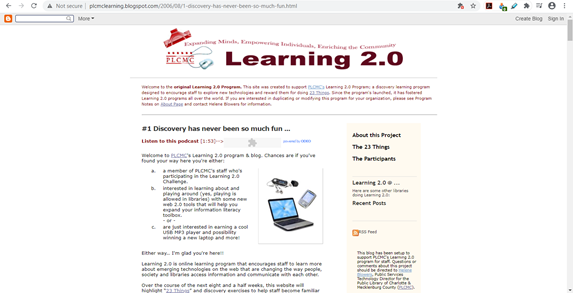I love the idea of exploration to learn. Particularly when it comes to new technology, the best way to learn about it is to try to use it. Whether it’s called “learning through play,” as described by the LEGO Foundation (2016) or Learning 2.0, the backbone of the 23 Things movement (2006), it makes sense to use that mindset in the library community, where so much technology is in constant flux.
I particularly love the ideas put forward by the 23 Things project—the idea that you will learn about 23 things by using them directly. It’s clear that some of this has been worked into our class, the fact that we create our blogs and experiment with WordPress, and that we investigate new trends and consider how to incorporate them into our workplaces.

I enjoyed going back and seeing how the 23 Things have evolved over time. The first projects looked at Web 2.0 tech — blogs, Wikis, RSS feeds, and photo-sharing sites like Flickr. The Oxford project added social media (2011), while Barwick (2013) turned her attention to more practical (and mobile) apps and scholarly tools like Skype, Dropbox, and Zotero. By the time Charles Sturt University posted their project (2017), they’re discussing current trends like online collaboration, digital curation, and open educational resources—and the project is now listed as shareable through Creative Commons licensure, which embodies the essence of Learning 2.0—sharing and building through exploration.
The challenge with using exploration as learning is that a) some learners need structure, and b) some institutions require structure and/or proof for tenure or promotion. You can see some of that reflected in the post on the professional development blog (2013), where the author points to other courses that can help librarians learn about (and play with) technology. Dr. Stephens notes this as well (2018) when discussing his conversations at the ALA conference: When asked about barriers to PLE, attendees responded that “how to get buy-in from administration” was a challenge, and that they need permission from their organizations to learn through exploration (Time for discussion, para. 3).
This takes me back to my context book assignment, where one of the main points of BiblioTech was that librarians need to network with and learn from other librarians (and non-librarians) to continually reinvent themselves and their libraries. But it seems like in most organizations, the pressure is on librarians to do such exploration on their own time, considering it as “playing around online” rather than the exploration needed to expand their technical skills.
References
23 Things for Professional Development. (2013, January 3). CPD for the new year. http://cpd23.blogspot.com/
Barwick, K. (2013, October 25). Welcome. 23 Mobile Things website. Accessed through the Internet Archive at https://web.archive.org/web/20200118223917/http://23mobilethings.net/wpress/ on November 11, 2020.
Blowers, H. (2006). About the Learning 2.0 project. PLCMC blog. http://plcmcl2-about.blogspot.com/
LEGO Foundation. (2016, July 5). What do we mean by learning through play? [Video]. Vimeo. https://vimeo.com/173458519
Oxford University Libraries. (2011, September 9). Oxford Social Media 2011: Presentations now available online. Oxford University Libraries 23 Things blog. http://23thingsoxford.blogspot.com/2011/09/oxford-social-media-2011-presentations.html
Stephens, M. (2018). PLEs @ ALA. Library Journal, 143(17), 10.